The Mike Toole Show
TAC-tical Withdrawal
by Michael Toole,
Just what becomes of an anime studio? I was left pondering that question back in 2010, when the sad news came down the wire that Group TAC, the great production house behind classics like Night on the Galactic Railroad, Yadamon, and of course, the Street Fighter II movie, had declared bankruptcy and gone dark for good. The news wasn't totally unexpected, but it was a pretty unfortunate turnaround-- just six years earlier, business was booming, with TAC doing good work on Area 88 TV, Viewtiful Joe, and the hit family film Arashi no Yoru ni. But fortunes can reverse abruptly in the entertainment business, and it seems like the death of studio founder and leader Atsumi Tashiro, plus a substantial load of debt-- almost $7 million by some estimates-- put the kibosh on Group TAC.
I've been thinking about Group TAC a lot lately, because their ghost is still roaming the streets of the anime world. In the UK, Manga Entertainment have released a drop-dead gorgeous blu-ray of their Street Fighter II movie, notable in no small part because it precedes a commercial HD release anywhere else in the world, including Japan. One of Group TAC's final projects, the movie The Life of Guskou Budori, was released to Japanese theatres last summer, and hit home video in January. The film, based on a story by the famous author Kenji Miyazawa, was in production when TAC went bust. Group TAC and anime based on the works of Kenji Miyazawa tend to have a common element, and that element is the director Gisaburō Sugii. I want to talk about all three.

Some artists who were present at the genesis of anime in the 50s and 60s have gone on to the great hereafter-- folks like Osamu Dezaki, Yasuji Mori, and Hiroshi Ōkawa. But we're pretty lucky, because other anime founders, like Rintarō, Isao Takahata, and Yoshiyuki Tomino are still with us. Gisaburō Sugii is part of that vaunted group, too. As a small child in postwar Japan, he saw the film Bambi, and knew right away that he wanted to pursue art and animation. Shortly after, his family moved from Numazu up to Tokyo. Young Gisaburo didn't have the means to fulfill his dreams of becoming an animator, simply because there wasn't much of an animation industry to speak of. But at the age of 17, he answered a job listing from Toei, who were launching a new animated films division. He passed the application test with flying colors, and got right to work as an animator on the studio's color cartoon feature debut, PANDA & the Magic Serpent. Sugii stuck with Toei through several films, working under the tutelage of the great Yasuo Ōtsuka, until he left for Osamu Tezuka's Mushi Production in ’61 – Toei's methodical, regimented approach to animating films just didn't hold his interest. Years later, Sugii would remark about how jarring a change moving from Toei to Mushi was—he knew that Tezuka's company was going cheap, but was still surprised by the company's usage of limited animation.
So there was Astro Boy, and that New Treasure Island TV special that I can't find the dubbed version of, and Goku's Great Adventures. And then there was that Lupin the 3rd pilot film, the one I wrote about way back in 2010. Jesus, I've been doing this thing for three years?! Sugii worked on that film, and watched in frustration as the planning around it went up in smoke. But happily, it did lead to the formation of a new studio, oddly enough headed up by the guy whose job was sound design. That was Mr Atsumi Tashiro, and his good planning meant that the work from the Lupin pilot film led directly to more work for the newly-formed Group TAC on the Lupin the 3rd TV series. TAC, hungry for cash and work, spent a couple of years following Yoshinobu Nishizaki's newly-formed Office Academy around, doing animation gruntwork on stuff like Marvelous Melmo and Space Battleship Yamato. But soon, it was time for their first major undertaking: a feature film project!
That feature film has the distinction of being anime's first ever full-blown musical; sure, many earlier films had sported a musical number or three, but Sugii's first big-screen directorial project, Jack and the Beanstalk, is positively bursting with music. You can probably point to the influence of Mr. Tashiro here, since he supervised the music for the film. The movie itself is quite straightforward; it starts with the building blocks of the fairy tale – a naïve farmboy, a cow to be taken to the market, and an unscrupulous man with magic beans. But Sugii and TAC add to the formula a wacky cartoon dog sidekick, plus a different spin on the giant at the top of the beanstalk – this one has a name (“Tulip”), a wicked witch mom, and an imprisoned princess for Jack to rescue. Visually, it's a fun, swinging, and creative flick. The movie actually sneaked into American theatres in 1976, courtesy of Columbia Pictures, before slowly becoming a cult classic thanks to cable TV screenings throughout the 80s (the DVD, which is for damn sure in my library, now goes for stupid money). My absolute favorite part of Jack and the Beanstalk, however, has gotta be Crosby the dog.
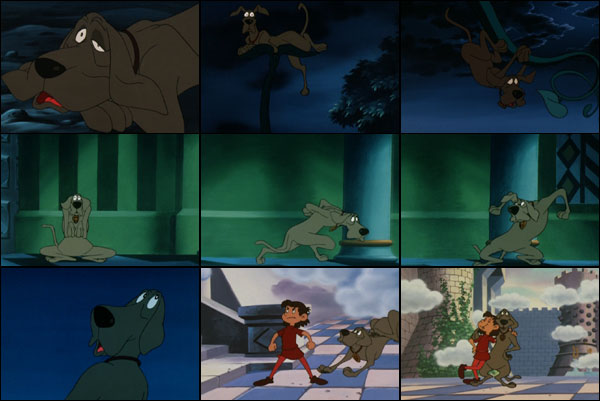
Frames like these are why I love cartoons so damn much. Not only is the dog floppy and rubbery and zany and fun to look at, it's pretty easy to tell that whoever was animating him had an absolute blast doing so. I'm not sure that this film had a specific animator assigned to the dog, but if I had to guess, I'd guess it was Shigeru Yamamoto, another veteran who'd go on to provide animation supervision for a bunch of Disney afternoon shows—so you can see right where he sharpened his silly-animal skills.
Group TAC's next big project would end up paying the bills for quite some time – a TV project entitled Manga Nihon Mukashibanashi, or “Manga Tales of Old Japan.” This series, directed by a coterie of greats that included Sugii, Rintarō, and Dezaki, plus many others, took a simple concept – hip, loose, stylistically varied retellings of famous Japanese Folk Tales and historical stories – and ran with it for almost 20 years straight. At its height, the series was stupidly popular, drawing 30% rating shares in both Tokyo and Osaka in 1981. There are some episodes (sadly unsubtitled) floating around the ether, and they're fun to watch – brief, accessible stories, but told with real wit and style by the creative team at TAC.
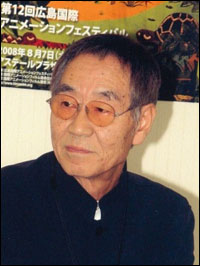
Sugii would spend the 1980s directing a whole shitload of baseball anime that I haven't seen – first a set of three feature films based on the Mitsuru Adachi manga Nine, and then then taking up a supervising director role for Adachi's famous Touch TV series. It's kind of puzzling that, of all of Adachi's superb and fiendishly addictive sports/romance stories, we've only got Cross Game to check out in English. But between Nine and Touch, Gisaburō Sugii worked on one of the finest unsung anime films of the 80s—Night on the Galactic Railroad.

This is another movie that's been covered pretty well by Justin Sevakis in his column, but it's important that I mention it here because it led to so much more down the road. Of the three Miyazawa-themed anime I discuss in this column, this film feels closest to the atmosphere Miyazawa created in his stories – an atmosphere of sweet twilight, the closeness of nature, a sense of melancholy, and for some reason, Esperanto. The artistic choice to render the film's main characters, Giovanni and Campanella, as anthropomorphic cats, was a relatively arbitrary one—Sugii and collaborator Hiroshi Masumura were struggling to come up with distinctive human character designs, so they changed the formula—but it would go on to define the look of two other famous Miyazawa anime titles. Miyazawa wasn't a fan of cats; he described them as “the only animals as selfish as human beings,” which makes them a pretty appropriate choice, I think.
Mostly, I'm just glad we've got a good animated adaptation of Miyazawa's story. The movie does a good job of depicting the book's wild imagery, from an eerie, space-traveling steam locomotive (sound familiar?) to a flock of herons that turn into candy when caught. If you check out the book (and you should), be patient and track down John Bester's translation. Not only is it the best-written translation (the easy-to-find Stone Bridge one is kind of hilariously awful, complete with changed names), it has my favorite translation of the title—Night on the Galactic Railroad is good, but I find Bester's title, Night Train to the Stars, more suitably mysterious.

I couldn't talk about Touch because I just haven't seen it, but way back in the VHS fansub days, I devoured a title directed by Gisaburō Sugii and produced by Group TAC, a 3-part OVA about a boy, a girl, and boxing. Nozomi Witches, an early-90s offering based on a popular and long-running shonen manga series, is an interesting beast – it's got Hajime no Ippo's Fighting Spirit and attention to technical detail, but just as important is the relationship between Ryotaro, the reluctant boxer, and the titular Nozomi, a mysterious new neighbor who forcefully and charismatically encourages the dude to take up fighting. In fact, Nozomi Witches’ boxing content is kind of silly – despite his lack of experience and training, Ryotaro turns out to be a reflexive genius who can knock out most of his high school opposition in one or two punches, Brad Pitt-from-Snatch style.
What pins the series together—and what Sugii does such a good job with—is the Bewitching Nozomi herself. The director's treatment of Toshio Nobe's original manga somehow manages to sell Nozomi from three different angles—as a siren-like, unnervingly perfect girl-next-door, as a tantalizingly attainable girlfriend, and as a tough, sympathetic inspirational figure. Naturally, she's voiced by Hiromi Tsuru, known to American fans as Ukyou in Ranma ½, firmly in her “likeable tomboy” mode. Like far too many 80s and 90s OVAs, there's no extant DVD version. Fansubs, sourced from old LD rips, aren't hard to find, but this is a title that deserves better.
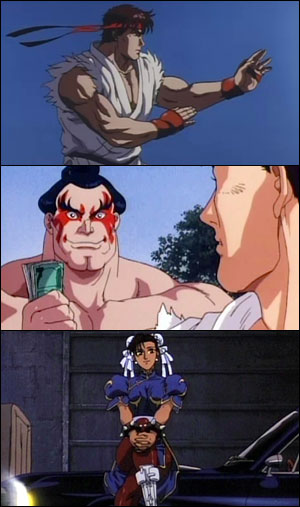
Street Fighter II: The Movie came in the wake of the Jean Claude Van Damme Street Fighter movie, and here in the US it was kind of hilarious to see how fans of the popular arcade game almost completely ignored the former, and flocked to the latter, making it a #1 Billboard video hit. To me, it seemed incredibly obvious that a high-budget, animated Street Fighter II movie was what fans actually wanted, not Van Damme and pals tangling with Raúl Juliá and Biff from Back to the Future. On its face, Group TAC and Sugii seemed like an odd choice to throw at CAPCOM's punchy-kicky game, with its very rudimentary storyline. But they ended up doing an amazingly good job, filling the movie's runtime with a multitude of fast-paced, kinetic fight scenes. The cold opening, featuring Ryu squaring off against Sagat during a thunderstorm, is one of the most effective I've ever seen in action anime.
One thing I appreciate about the film is that it doesn't make the mistake of trying to throw as much screen time as possible to every single character—the movie includes everyone, even Dee-Jay and T-Hawk, but it's mainly about Ryu and Ken's rivalry, Guile and Chun-li's weird team-up/tension, and the fight against the evil Bison/Vega and his army of ki-sensing cyborgs. In the field of video game anime, which has a lot of extremely weak entries, Street Fighter II is pretty damn strong. Manga UK's blu-ray is first rate, leaving me hoping that a US release is in the future, because not everyone is crazy enough to have a multi-region bluray player like I do. Finally, be sure to enjoy the dub, and listen carefully to Bruce Lee imitator Fei Long—because, yep, that's Bryan “Breaking Bad” Cranston doing his voice! Sugii followed this film immediately with Street Fighter II V, a cheap but fairly enjoyable TV origin story/alternate retelling of the Street Fighter story. In a mixed blessing, this cartoon was kept off of American TV for years by the famously terrible American Street Fighter cartoon. I'm glad we eventually got both of ‘em!
Sugii would close out the 1990s doing stuff like the Lupin the 3rd: Secret of Twilight Gemini special, Soar High! Isami, and Hidamari no Ki, which… you know, that's actually a good movie. I wonder why we never got that in English? Anyway, I'm more interested in talking about what Group TAC was doing as the 2000s approached; they had a TV special in the pipeline, a biographical piece about the famous Kenji Miyazawa. The twist? It was going to feature the writer as a cat, just as with the characters of in Night on the Galactic Railroad, and the whole thing was written and directed by Shōji Kawamori. If you've watched Kawamori's work, you know that this can be a double-edged sword, but I like what he ended up doing with the special, which was released in English under the title Spring & Chaos. It depicts key events in Miyazawa's life – his care for his infirm sister, struggles with his own illness, and his relationship with his students – with more than a touch of surrealism.

The special has some other finer points—seriously awesome music by Shang Shang Typhoon, character designs by the prolific Takahiro Kishida, and a really bizarre, awkward dub, which was one of the first projects by Stu Levy's TOKYOPOP. The secondary character performances are fairly terrible, but Ron Jaxson's turn as Kenji, while totally incongruous (his accent just sounds a bit weird) is strangely compelling. Kawamori boldly depicts Miyazawa's creative process, particularly when he's writing poetry, as the product of synaesthesia, the confusion of senses, which is neat to see in animation. Sadly, this very pretty featurette got a truly ugly DVD release, and has never really gotten any better treatment. If you're curious about the dub, you can watch it on Hulu.
As the 90s became the 2000s, Group TAC's next project, The Daichis: Earth Defense Family, hit the airwaves. This series is notable for a few reasons: it was created by the aforementioned Shōji Kawamori. Character designs are by Kazuaki Moori, who happens to also be character designer on some no-name show called Pokémon. Maybe most interestingly, it was the last TV series to extensively use cel animation before pretty much everyone went to digital. What sucks is that the Daichis is a good, fun little comedy, sort of a weird spin on The Incredibles with a reluctant nuclear family using mysterious technology to fend off alien invaders, but there was no way it was ever going to get noticed in North America, despite a dub and DVD release. I'm partial to the Japanese version, which featured hardened veteran seiyuu Akira Kamiya and Mami Koyama as mom and dad. Finally, that third disc contains an unaired episode—specifically, an early cut that ended up being drastically altered and discarded, a huge rarity in the waste-averse world of animation.
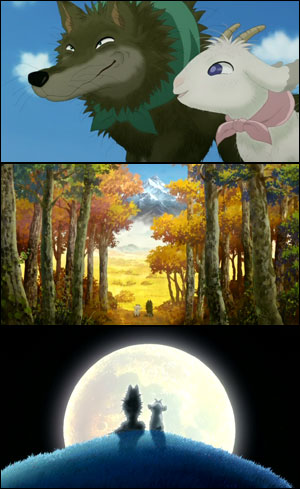
One of Group TAC's biggest commercial successes came late in their history: 2005's Arashi no Yoru ni, or One Stormy Night. I'm seriously a bit shocked that there hasn't been some sort of commercial release of this in North America – it's a good-looking piece of theatrical animation that's family-friendly and easy to adapt. As it stands, though, One Stormy Night capitalized well on the popularity of its source material, a children's book about a wolf and a goat hunkering down in a barn during a bad storm and becoming unlikely friends, and made millions at the box office.
But how's the actual movie? Visually, it stands well apart from most of Sugii's work—it employs a lot of CG, but still maintains an appealingly flat 2D look. The basic story – wolf and goat, blinded by a dark night and crazy thunderstorm and unable to smell each other due to a bad case of the sniffles, spend an evening talking about their fondness for nature and exploration, and decide to meet up later – is a neat spin on the ages-old “improbable friends” formula. When they encounter each other again, hell fails to break loose. “When you didn't try to eat me right away, I knew we'd be okay,” says the goat, Mei. “That's right,” replies Gabu the wolf, “I value friendship over food!” The rest of the film plays out across sweeping plains and mountains, as the pair discuss their differences and figure out how to preserve their friendship in the face of their respective peers, who are more interested in playing their natural predator-prey roles. One Stormy Night goes on for a bit too long – its 100 minutes could easily be tamped back to about 85 – but it's a beautiful and enjoyable little film. Group TAC did well by it, and it's a damn shame that its success wasn't able to sustain the studio when the going got tough.
That brings us to The Life of Guskou Budori. Two things about this film, which is another Kenji Miyazawa tale, adapted with cats as the main characters: it's not the first Guskou Budori film. Studio Animaruva created an animated movie featuring human characters in 1994, directed by Serial Experiments Lain's Ryūtarō Nakamura. I haven't seen this film, and there doesn't seem to be a DVD release for it. Secondly, Group TAC were in production on this newer movie when they went under. It can be a hell of a thing when this happens – witness what the death of director Satoshi Kon did to his final film, The Dreaming Machine – but Bandai Visual, a committee member who'd kicked in sponsorship money, patiently kept the staff and materials together long enough for Tezuka Productions to step in and get the movie finished. Kudos to them for doing that! Guskou Budori isn't perfect, but it's a very worthwhile film.
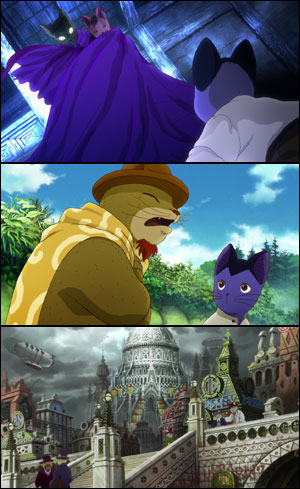
This movie isn't quite as affecting as Night on the Galactic Railroad, but it's an intensely personal story that seems to echo parts of Kenji Miyazawa's own life. Budori and his parents and sister live in the woods of Ihatove (Esperanto for Iwata, natch). They live happy, simple lives until a prolonged cold snap and famine wreaks havoc on the whole family. Realizing that he can't stay in the forest, Budori strikes out to find a place in the world, deeply troubled by the tragedies he's witnessed. In one chapter, he helps an ambitious but reckless farmer, devising new ways to kill plant diseases in the process; in another, he works as a volcanologist, studying volcanoes in a huge, glittering city to work out how they might benefit and ultimately save the people.
The Life of Guskou Budori is bracketed by Miyazawa's most famous poem, “Not Defeated By the Rain," and the poem's strong air of patience and benevolence is baked right into the film as a result. This really helps; without it, Budori might seem naïve, or hopelessly optimistic, but his frequent remembrance of it does well to communicate the character's deep and abiding concern for the people. Like in Galactic Railroad, the cat motif is employed skillfully; it makes Budori and his family and friends both distinctive and a bit otherworldly. I particularly like the way Sugii employs feline faces in dream sequences – most of the movie's cats have rounded, human eyes, but a few characters who seem to sit on the fringes of the film's reality have slitted pupils.
Considering the turbulence of TAC's passing, it's a minor miracle that The Life of Guskou Budori is both intact and pretty damn great. Gisaburō Sugii's still making quality movies, and keeping the ideals of Miyazawa, one of Japan's great literary masters, alive. Night on the Galactic Railroad is still a better film – Guskou Budori simply isn't as existentially awesome and compellingly weird, but it's a more than worthy companion. The only thing that gnaws at me is the fact that Group TAC is gone. They were a genuinely wonderful studio who always seemed willing to give their artists the freedom to take risks. I just hope that other studios don't watch what happened to TAC, and scale back their own creative, personal endeavors. We need more anime like this!
discuss this in the forum (15 posts) |